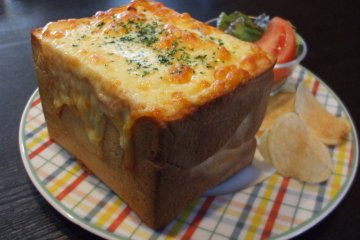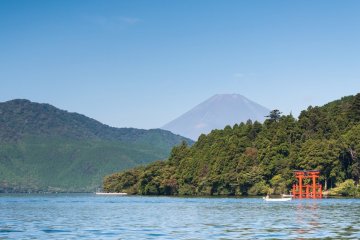
Pan-no-mimi
在 Pan-no-mimi,您可以嘗試一些美味和獨特的麵包。 除了各種熱三明治,如金槍魚起司或火腿切達起司,不要忘記它們的烤麵包——例如是以烤海鮮和起司烤成的半條鮮烤麵包。

The Hakone Shrine is a Japanese Shinto shrine on the shores of Lake Ashi in the town of Hakone in the Ashigarashimo District of Kanagawa Prefecture. It is also known as the Hakone Gongen. [Wikipedia]

在 Pan-no-mimi,您可以嘗試一些美味和獨特的麵包。 除了各種熱三明治,如金槍魚起司或火腿切達起司,不要忘記它們的烤麵包——例如是以烤海鮮和起司烤成的半條鮮烤麵包。

Box Burger 提供縣內最好的足柄牛肉漢堡。 當您點一份他們多汁的厚漢堡時,別忘了有一份手工製作的奶昔來搭配。 在這裡嘗試由京都阿拉比卡咖啡豆製成的溫哥華咖啡,它一定會為您提供能量,讓你在接下來的旅程中繼續前進!

Over 3,000 years ago, Mount Hakone’s eruption created a large volcanic crater, leading to the formation of Lake Ashi (Ashi-no-ko) in Hakone, Kanagawa Prefecture. This stunning work of nature has become iconic thanks to its breathtaking views of Mount Fuji. On clear days visitors can see the unmistakable mountain rising above the trees and, occasionally, witness its reflection in the still waters. Surrounding Lake Ashi is a relatively undeveloped coast of lush woods and quaint onsen towns. Nestled in the forests encircling Lake Ashi are notable destinations such as Hakone Shrine, the Hakone Detached Palace Garden, and Moto-Hakone. Hakone Shrine, located on the southern end of the lake, is situated just off the shore with its red torii gate seemingly floating in the water and its similarly vibrant shrine buildings standing sheltered in the trees. Also located on the southern shores, is the Hakone Detached Palace Garden, a remnant of the summer palace for the Japanese Imperial Family. The garden, called Onshi Hakone Park, has scenic walking trails and some of the area’s best views of Mount Fuji. Nearby the garden is Moto-Hakone, which is one of the towns where boat tours often depart. Apart from the town’s port activity, Moto-Hakone is regarded as another prime location to observe Mount Fuji.

Be awed by storm clouds of volcanic steam that gather over the active volcano, Owakudani (大涌谷), the Great Boiling Valley. Created around 3,000 years ago, today the crater-valley is a popular tourist site, despite the ominous and evocative name. The volcanic valley is still alive today with active sulfur vents and hot springs. Once called the “Grand Inferno” or “Great Hell” thanks to the streams of white sulfuric smoke reaching toward the sky, it was renamed when the Meiji Emperor and Empress visited Hakone in 1873 because locals hesitated to invite the two to a place with such a foreboding name. Marvel from the Hakone Ropeway, 130 m above the valley bottom. Sulfur and water vapor pour out at about 100°C. The terrible landscape creates an image of hell that had even famed Japanese Buddhist monk, Kūkai, offer a prayer to Bodhisattva at the sight. At sunset, the sunlight from Lake Ashi glitters off the waters to offer a beautiful sight one might not expect next to the nightmarish landscape. While here, be sure to try the legendary kuro-tamago—hot spring hard-boiled eggs with shells turned black by the iron sulfide in the volcanic waters—these treats are only available at Owakudani. Eating one is said to add seven years to your life. At the top of the observation deck overlooking Owakudani you might even spot the majestic Mount Fuji on a fine day, this being one of the best spots to see it from. Access Owakudani by the Hakone Ropeway from Owakudani Station, or by bus. Although it is advised that people with asthma, bronchitis, heart disease, pacemakers, and pregnant women not enter the valley due to high volcanic activity. The volcanic gas concentration and temperature are constantly measured at the Hakone Ropeway stations to ensure the safety of guests and the site may be temporarily closed due to high levels of gas or volcanic activity. Volcanic alerts were lifted on Friday Nov 15th 2019, ending a six-month closure that saw most parts of the Owakudani area temporarily closed to access due to an increase in volcanic gases. The area is now safe to access, though it is advised that those with respiratory problems, heart conditions, pregnant women or young children do not enter the valley due to slight risk from volcanic fumes.

雖然是個窮苦留學生 還是努力擠出一點錢 規畫了一下短暫的年假 想說很久沒自己一個人出遠門走走了 所以就決定去了箱根 從新宿站 一天來回而已 也沒泡溫泉 大家應該覺得傻眼吧? 本人對於溫泉一點興趣也沒有= = 想到一下脫一下穿 還要全裸跟一群歐巴桑泡在一起 就算他們再怎麼和藹可親 我還是不敢嘗試 日本人倒是覺得我們台灣人穿泳衣泡溫泉很奇怪 無法達到完全放鬆的境界 而且 在日本阿 還有男女混浴 全裸喔= = 不過都只有阿公阿嬤敢泡啦 再說 一個人泡也太孤單了 今天有暖呼呼的太陽陪伴 在電車上我還熱到圍巾跟外套都脫下 一到了中段 窗外的風景開始漸漸有鄉村的感覺 [photo] 相當喜歡紅色的椅墊 很想躺下來霸占整個車廂 笑 還瞥見有個老伯在遠處畫畫寫生 可惜來不及拍下 大概坐了一個小時半 終於到了小田原站 跑到了最前端 看見一個年輕爸爸抱著小男娃 一起等著下一班列車進站 車掌也等著交接 [photo] [photo] 接著就要去搭登山電車囉 在箱根湯本站下車 約莫15分鐘 只顧著哇哇哇的驚嘆 都忘了拍下沿途風景 噗 還沒完 再轉搭登山巴士 很好 暈死我了 早知道就吞顆暈車藥 路上九彎十八拐的 有種其實是去九份的錯覺 今天的主要目的地是 小王子的博物館 全世界 就這麼一個而已喔 雖然這是暢世名作 我卻從沒翻過 真是有點過意不去 可是今天來到這邊後 真的會讓我想去圖書館借來看 [photo] 光是入口大門 就會開始對裡頭更加充滿期待 [photo] [photo] 頭一次讓我的學生證發揮功能 只要是學生就可享有400日幣折扣喔 一般入場是1500日幣 [photo] 我手裡拿著的其實是地圖簡介喔 是 一朵玫瑰 還可以整個拆開 非常精緻 [photo] 完全讓人是置身在歐洲阿阿阿 [photo] 阿...多希望自己家的陽台就是長那樣子 伸個懶腰喝杯咖啡 [photo] 據可靠可靠消息指出 這個博物館還不是很多人知道 台灣的旅遊書上很少會寫到 所以人潮不會很多喔 [photo] 繞了半圈終於看到有顏色的小王子本尊囉 [photo] 鏡子反射的是真的樹枝喔 顏色鮮艷的超不可思議 內部也有的逛喔 兩層樓都是關於作者的生平簡介和故事的由來 還有影片觀賞喔 不過沒有字幕 日文發音 完全是在考驗我的聽力= = 不過也因此發現 原來我的女神宮崎葵 曾經演過小王子的真人版舞台劇!!!!!!!!我要翻出來看!!! [photo] 餓的話可以到這邊用餐喔 紀念品館就在正後方 還好我都保住荷包了 呼 [photo] 雖然聖誕節過了 但這個燈飾會開放參觀到1/9號喔 太陽下山後就會開燈 很想留下來看 可是.......很怕凍僵在這邊 還是趕緊下山好 而且下山還塞車= = [photo] 大約四點天氣就會開始變冷颼颼的 溫度應該只有三度 就這樣在路邊等巴士吹風吹了十分鐘 嗚 網誌原文:http://vov1232001.pixnet.net/blog/post/40844713